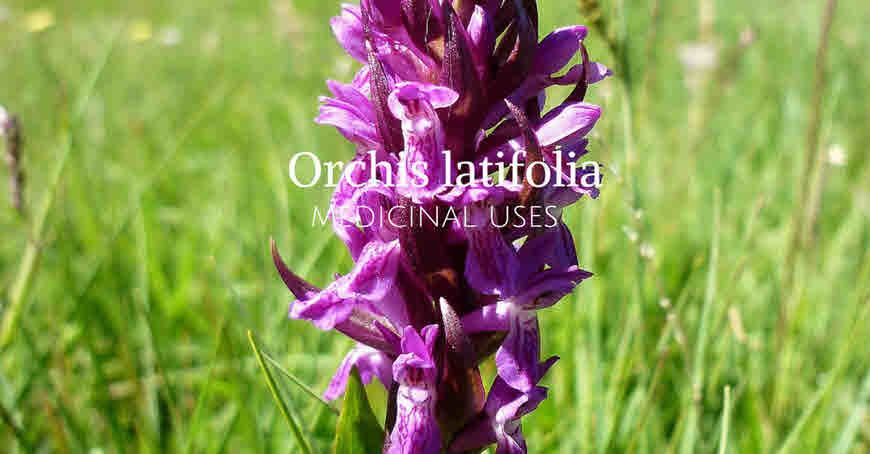Orchis latifolia Linn. is commonly known as Panja, Salam-Panja, Salep, Hath-Panja or Hatajari. It got all these local names due to its hand like roots. The appearance of its root is like a palm with fingers. Salam-panja is found in Himalaya at altitudes of 2, 500-5000m in damp places. It is an orchid plant and bears purple flowers. It has fleshy tuberous roots. These roots are used for medicinal purpose.

In Unani, the roots of the plant are considered aphrodisiac and nervine tonic. The roots are cooling, emollient, aphrodisiac, rejuvenating and tonic.
Vernacular Names
- Hindi: Salampanja, Salam
- Ayurvedic: Munjataka, Saalam-misri
- Kannada, Malyalam, Telugu: Salamisri
- Marathi: Salum
- Uttarakhand: Hattha jadee
- Kashmir: Salem panja
- Ladakh: Angulagpa
- English: Salep orchid
- Siddha: Silamishri
- Trade name: Salep
Latin Name: Orchis latifolia Linn.
Family: Orchidaceae (orchid family)
Part used: Tuber root
Native to: Indian Himalayan region
Distributed in: India (Jammu and Kashmir, Sikkim, Arunachal Pradesh, Uttarakhand, and Himachal Pradesh), Pakistan, Afghanistan, Nepal, Tibet and Bhutan.
Description:
Perennial herb, up to 60 to 70 cm in height;palmately lobed, Fleshy, tuberous divided root tubers;leaves many, erect, oblong broadly lanceolate arranged more or less along the stem;Flower: dull purple in spikes.
Medicinal Uses of Salep
The roots of the plant are used Ayurveda, Siddha and Unani for the treatment of many diseases. They are used to cure dysentery, diarrhea, chronic fever, cough, stomachache, wounds, cuts, burns, fractures and general weakness.
The root tubers are rich in starch, mucilage, sugar, phosphate, chloride and glucoside-loroglossin. They yield a ‘Salep’ which is used in traditional medicine.
Salep is used as food, expectorant, aphrodisiac and as a nervine tonic. The dried and ground root powder is taken with milk to increase vigourness. It is ingredient of many Unani medicines which are used for sexual weakness, low sperm count and spermattorrhoea.
Roots have astringent and aphrodisiac properties. Clinical trial shows that the herb is also used to increase the testosterone level and also help to increase sexual desire.
The roots are cooling in nature.
They are Tonic, rejuventive and used in the treatment of wasting diseases.
The Dosage of Root powder
The root powder is used in a dose of 3-5 grams. Generally one teaspoon root powder is cooked in one cup milk and given for diabetes, dysentery, diarrhea, weakness and all kind of wasting diseases.
Reference
Badola HK, Aitken S (2003). The Himalayas of India: A treasury of Medicinal plant under siege. Biodiversity, 4:3-13
Baral SR, Kurmi PP (2006). A compendium of medicinal plants in Nepal, Katmandu, Nepal
Samant SS, Dhar U, Palni LMS (1998). Medicinal plants of Indian Himalayan: Diversity, Distribution Potential Values. HIMAVIKAS Publication. No.13, Gyanodaya Prakashan. Nainital, India
Pant S, Rinchen T, Dactylorhiza hatagirea: A high value medicinal orchid. J Med Plants Res, 6(19):3522-4, (2012)
Thakur M, Dixit VK (2007). Aphrodisiac Activity of Dactylorhiza hatagirea (D.Don) Soo in Male Albino Rats. Evid. Based Complement Alternat. Med., 4(1):29-31
Thakur M, Dixit VK, Ameliorative effect of Fructo-Oligosaccharide rich extract of Orchis latifolia linn. on sexual dysfunction in hyperglycaemic male rats. Sex Disabil, 26(1):37-46(2008)
Ved DK, Kinhal GA, Ravikumar K, Prabhakaran V, Ghate U, Sankar RV, Indresha JH (2003). CAMP Report: Conservation assessment and Management prioritization for Medicinal plant of Jammu and Kashmir, Himachal Pradesh and Uttaranchal. In: Workshop at Shimla, Himachal Pradesh.
Vij SP, Srivastav RC, Mainra AK (1992). On the occurrence of Dacty
Singh A, Duggal S, Medicinal Orchids – An Overview. Ethnobot Leaflets, 13:399-412, (2009)